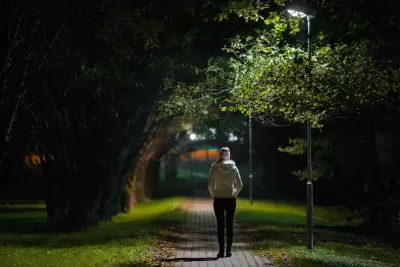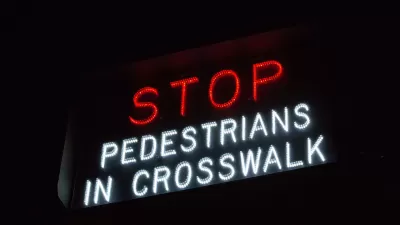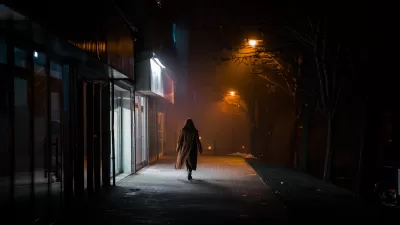A lack of effective lighting in streets, parks, and transit stations limits the places where many women and other vulnerable groups feel safe traveling at night.

A report from Transport for New South Wales highlights the disproportionate safety concerns faced by women in cities after dark, reports Elias Visontay in The Guardian.
In an Australian survey, almost two-thirds of female respondents expressed feeling unsafe walking at night, as opposed to 31 percent of men. “Despite research finding more lighting at night would be popular with many people, councils and other authorities often hesitate installing lights in public areas,” Visontay explains.
Advocates say they want to see a balance between the need to protect local wildlife with improving safety for pedestrians. In Melbourne, a series of high-profile murders prompted city officials to light a popular running path until midnight every day.
“It’s not just parks. Walking to and from public transport, as well as waiting at bus stops and train stations, can feel unsafe if there is no adequate lighting,” according to Professor Nicole Kalms, who studies the issue of gender-sensitive design.
The problem stems in part from the dominance of men in many aspects of the transportation planning field. “Transport technology company NEC has calculated that only 20% of senior transport roles in Australia are held by women, and women account for only 4% of CEOs in the industry.” This lack of women’s representation has led to poor outcomes when it comes to lighting and security, transit routes that serve women’s and children’s needs, and other aspects of mobility.
FULL STORY: ‘Not safe to run in the dark’: how inadequate lighting in public spaces is creating barriers for women

Maui's Vacation Rental Debate Turns Ugly
Verbal attacks, misinformation campaigns and fistfights plague a high-stakes debate to convert thousands of vacation rentals into long-term housing.

Planetizen Federal Action Tracker
A weekly monitor of how Trump’s orders and actions are impacting planners and planning in America.

In Urban Planning, AI Prompting Could be the New Design Thinking
Creativity has long been key to great urban design. What if we see AI as our new creative partner?

Car Designs Make it Harder to See Pedestrians
Blind spots created by thicker pillars built to withstand rollover crashes are creating dangerous conditions for people outside vehicles.

Cal Fire Chatbot Fails to Answer Basic Questions
An AI chatbot designed to provide information about wildfires can’t answer questions about evacuation orders, among other problems.

What Happens if Trump Kills Section 8?
The Trump admin aims to slash federal rental aid by nearly half and shift distribution to states. Experts warn this could spike homelessness and destabilize communities nationwide.
Urban Design for Planners 1: Software Tools
This six-course series explores essential urban design concepts using open source software and equips planners with the tools they need to participate fully in the urban design process.
Planning for Universal Design
Learn the tools for implementing Universal Design in planning regulations.
Appalachian Highlands Housing Partners
Gallatin County Department of Planning & Community Development
Heyer Gruel & Associates PA
Mpact (founded as Rail~Volution)
City of Camden Redevelopment Agency
City of Astoria
City of Portland
City of Laramie





























